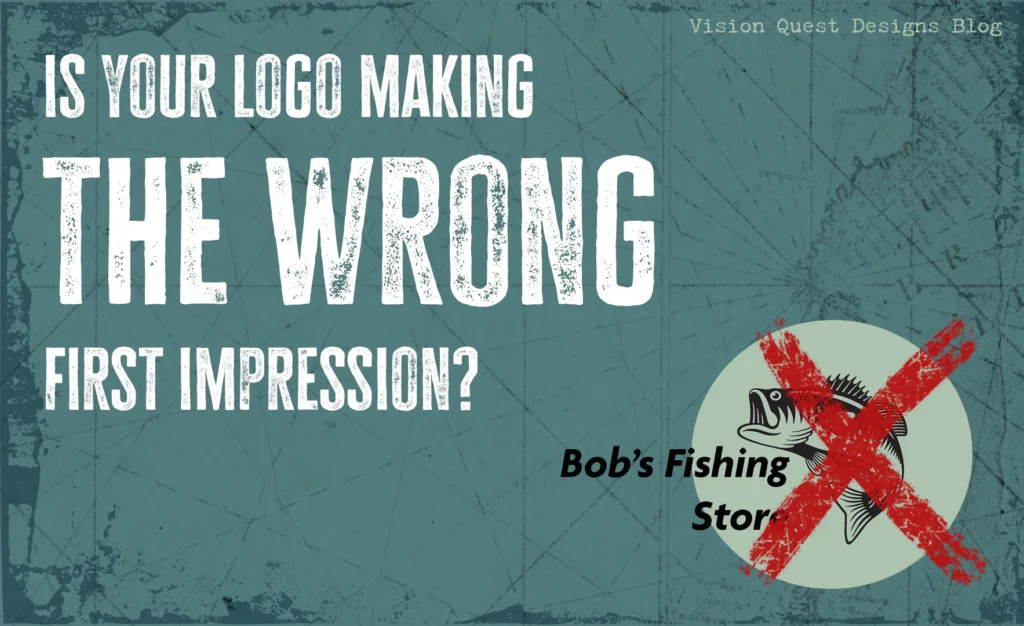One of the reasons why Vision Quest Designs was founded and specializes in the outdoor industry is because it’s what we love to do and are truly passionate about. We love being out on hikes, camping, fishing, ect., and just like everyone else, we geek out on the latest gear and shiny new things. Something we often notice is that so many businesses have an incongruence between their products, and their visual identity. What I mean is that often, brands have amazing products or services that they are very proud of, and truly stand out, but their logo, or their packaging, or their website, or all of the above are atrocious! This first impression of a brand can result in a complete turn off, and potential clients may just pass you by. Once an impression is formed, it can be difficult to change. However, If it’s a positive impression, people are more likely to engage with you favorably in the future.
Your logo is your unique mark, it’s like a signature, your personal stamp. Using a generic-looking logo gives the impression that you run a generic business. Unfortunately, many businesses overlook this key detail, and opt for something quick, cheap and easy. In this post we will discuss why this happens so often, and then point out a couple key differences between a bad logo and a great logo.
Lack of Awareness
When starting a business, there is a so much to take into account. Usually new business owners are going into the venture because its something they love. They are very knowledgeable in that industry and want to share their passion for it through their own products, services or store. Building and running the business is already a huge undertaking, and often in order to bring their business to market, they overlook how their business is represented visually. Some think a logo is just a decorative element rather than a strategic branding tool, and take the approach that “any logo will do”. What they don’t realize is that a poorly designed logo, or using clip art or even a logo generated with AI, can make your customers assume that your company lacks attention to detail, credibility, and that your offerings are subpar.
"I often think about it in fishing terms..."
Prioritizing product development or service quality
We understand that your products or service are what truly drives your business. After all, you can have a great presentation, but if the product sucks, word will spread and your business will be dead in the water. Ideally, you will want to match the quality of your product or service with your visual identity. This puts you in alignment with excellence and it will be clear to your customers that you pay attention to every detail of your business to provide the best experience. We live in an extremely competitive environment, and if you are leaving an opportunity for a competitor to visually outshine you, they will take it. There are many similar products and services out there, and in a time where everyone is fighting for attention, you want to make your brand stand out. I often think about it in fishing terms. If you’re casting lures, you want yours to get the fish’s attention immediately, to be irresistible and different from anything else around them! Any serious fisherman will tell you to invest in the good stuff, otherwise you’re wasting your time. Same goes for your logo.
Budget Constraints
Starting and running a business is expensive. Many startups and small businesses prioritize other expenses over professional business identity design, opting for cheap or DIY solutions. Far too often we see logos that were crudely made by the business owner, and there is little to no consideration for brand colors, typography or anything that contributes to brand consistency. I get it, when I started my fist business, that wasn’t at the top of my list either. It took a lot of experimenting and making mistakes before I learned that lesson. I understand wanting to do everything yourself to save money and not wanting to relinquish control, however an investment into a professional logo and brand identity can save you years of headaches and set you on a plan toward long-term brand growth and scalability. Consistency builds trust and customers will be more willing to do business with you if you offer a trustworthy impression.
So what is a great and bad logo?
This is a very subjective topic because the style and mood of a logo really depend on the type of business represented. There are a few key aspects to consider though that contribute to a great logo:
1.) It should communicate the brand’s values, mission, and industry relevance.
2.) It should be simple, versatile, and easily recognizable.
3.) It should be distinctive and unique.
I realize there is so much more that could be discussed about what makes a great logo, and really deserves its own blog post, probably a few actually. I believe I have given you some food for thought though. I’m sure there are a few companies you can think of that have great products but awful logos (hopefully not yours!). Just remember that a logo that looks amateurish or cheap is likely to make potential customers hesitate to do business with you, fearing that your company isn’t reliable or established. Next time you see a logo you like, or don’t like, think about these 3 aspects I’ve posted to give you insight into why they do or don’t work.

Diego is the founder and CEO of Vision Quest Designs. He lives in Florida and when not designing, he enjoys fishing, hiking, painting and wildlife photography.

